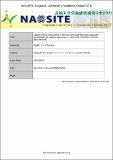| dc.description.abstract | Live food resources e.g. rotifers, copepods, cladocerans and Artemia are critical
for successful fish larviculture. However, the hatchery production of these live foods
depends on the availability of high density microalgae, which is unstable, laborious and
costly to produce, thus impedes the development of larviculture, especially in most
tropical countries. This study developed three low-cost and stable live food production
protocols, with specific reference to brachionid rotifers, for mass culture initiatives and,
applications in the larviculture sector.
Firstly, a study was conducted to investigate the population ecology of a common
freshwater rotifer species in Kenya, using individual life table and small batch cultures,
to advance the knowledge of rotifer fauna in Kenya (Chapter II). The rotifer cysts were
sampled from pond sediments in Kenya and transported to Nagasaki University for
further study. The rotifer was morphologically identified as Brachionus angularis,
before conducting the ecological studies at 20, 25 and 30°C using fresh Chlorella
vulgaris diet at 2.5×105
, 2.5×106
and 2.5×107
cells ml-1. The rotifer was most fecund
(2.11±0.07 offspring female -1 day -1) and reproductive (8.43±0.24 offspring female -1)
at 25oC with 2.5×106
algal cells ml-1. The highest intrinsic rate of natural increase
(0.74±0.02 d-1), specific population growth rate (0.49±0.01), longest life expectancy at
hatching (12.41±0.28 d) and shortest generation time (2.87±0.03 d) also occurred at
25oC with 2.5×106
algal cells ml-1
. The duration of hatching to first spawning was
shortest (2.86±0.21 h) at 30oC with 2.5×107
algal cells ml-1 and longest (8.83±0.39 h) at
20oC with 2.5×105
algal cells ml-1
. The highest population density (255.7±12.6 ind ml–1)
occurred at 25oC with 2.5×106
cells ml-1 on day 8. The Kenyan strain of B. angularis
has small lorica size (length: 85.6±3.1 µm; width: 75.4±3.6 µm) and, reproduces
optimally at 25oC with 2.5×106 algal cells ml-1; thus suitable for feeding small-mouth
freshwater fish larvae.
To enhance mass production of this rotifer species, for aquaculture, a chicken
manure extract (CME) technique was developed, and its effects on the population
growth, mixis induction and body size of the rotifer was determined (Chapter III). Four
concentrations of CME (i.e. 0.5, 1.0, 2.0 and 3.0 ml l-1) were added to different glass
jars containing 20 ml of sterilized pond water, in which 30 clones of rotifers were
cultured at 25oC, and daily fed with 2.5×106
cells ml-1 of C. vulgaris for 7 days without
aeration or water exchange. The rotifer’s specific population growth rate and population
density increased significantly with 2.0 ml l-1 of CME, without altering the lorica size.
ii
The mictic response decreased with increasing concentrations of CME. Therefore, 2.0
ml l-1 of CME is optimal for enhancing the mass culture of the rotifer B. angularis.
To reduce overdependence on the freshly cultured microalgae for live food
production, dried algae have often been used but cases of culture crash are common,
thus requiring techniques to stabilize them. In chapter IV, dried Nannochloropsis
oculata and Chlorella vulgaris were used to culture the euryhaline rotifer Brachionus
rotundiformis (SS-type) with gamma-aminobutyric acid (GABA) supplementation.
Firstly, the efficacy of GABA was tested during the lag phase of rotifer growth and
every 2 days in small cultures (300 ml). Then, the rotifers were exposed to GABA for
24 and 48 h before up-scaling to 20 l cultures. GABA enhanced rotifer population
density and egg/female ratio in both foods compared to the control. Pre-GABA
incubation for 48 h caused higher rotifer population densities on days 5 and 6 (with both
foods) and 8 and 10 (with C. vulgaris), than their respective controls.
In chapter V, a study was conducted to eliminate the expensive microalgae from
aquaculture production chain. Here, a protocol was developed for making a low-cost
fishwaste diet (FWD) that was used to culture the rotifers B. rotundiformis (SS-type),
after several culture failures with B. angularis. About 0.5 g l-1 of fishwaste was wrapped
in plankton net (200 µm) and placed in the rotifer culture medium. Then, 0.2 g l-1 of
starch (wheat flour) was added into the culture as carbon source. Three diets i.e. FWD1
(fishwastes only), FWD2 (FWD1 + starch) and control (C. vulgaris only) were each
triplicated in 30 l polycarbonate tanks containing sea water (22 ppt), in which 20 rotifers
ml-1 were stocked and cultured at 28±1oC without aeration for 18 days. The FWD, as
food source, was used to determine the population growth, mixis rate and nutritive value
of the euryhaline rotifer, B. rotundiformis (SS-type) (Chapter V.1). Half of the culture
medium was replaced at every rotifer exponential growth phase and, fresh treatment
added. The stability of the cultures was determined by the coefficient of variation (CV)
of the mean specific growth rate (SGR). The total lipid content of the rotifers and the
microbial flora were also analyzed. The FWD suppressed rotifer mixis rate but favoured
parthenogenetic reproduction. FWD2 produced significantly higher rotifer density than
FWD1 and control diet, where up to 1,188±69.7 rotifers ml
-1 was obtained between 8-13
days with FWD2. There was no significant effect of FWD on the CV (0.08-0.11) of the
cultures. About 0.35 and 0.39 mg g-1 of DHA and EPA, respectively was obtained in the
FWD-fed rotifers and, both were under detectable limit in the control-rotifers. The
DHA/EPA ratios were 2.7, 0.9 and 0.0 for bioflocs, FWD-fed rotifers and control- | en_US |

